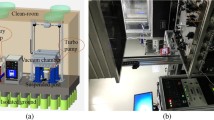Abstract
Laser wireless power transmission (LWPT) is one of the effective ways to provide long-distance convenient and perpetual energy supplies to electronics. Especially in space power satellite (SPS), LWPT can be used to transfer energy not only to ground, but also to other spacecrafts, which applied for satellite rescuing, spacecraft maintaining in orbit. In space application, LWPT system has characteristics of long distance, higher power, precisely aiming accuracy and better adaptability to space environment. In this paper, we propose a long distance LWPT system in SPS. Firstly the system diagram, composition and key technologies are described, which include the selection of laser, the collimated and expanded module of laser beam, the principle of the optical-to-electrical conversion efficiency of InGaAs photovoltaic cell for the high intensity laser with different laser wavelengths, the Acquisition Pointing and Tracking (APT) system and the Maximum Power Point Tracking (MPPT) technology. Then the LWPT system in SPS is designed, which composed of laser transmitting subsystem, laser receiving subsystem, APT platform and energy managing subsystem. Finally, we evaluate the power conversion performance of LWPT by simulation, which illustrates that the system can achieve better energy transmission effect under the condition of transmission distance of 400 km (space to ground) and beam pointing accuracy of 5 μrad.













Similar content being viewed by others
References
Glaser PE (1968) Power from the sun: its future. Science 162:867–886
Oda M, Mori M (2004) Conceptual design of microwave-based SPS and laser-based SPS. In: International Astronautical Federation 55th International Astronautical Congress
Zhang Q, Fang W, Liu Q, Jun Wu, **a P, Yang L (2018) Distributed laser charging: a wireless power transfer approach. IEEE Internet Things J 5(5):3853–3864
Mahmood A, Ismail A, Zaman Z, Fakhar H, Najam Z, Hasan MS, Ahmed SH (2014) A comparative study of wireless power transmission techniques. J Basic Appl Sci Res 4(1):321–326
Sung-Man K, Dong-Hun R (2018) Experimental demonstration of optical wireless power transfer with a DC-to-DC transfer efficiency of 12.1%. Opt Eng 57(8):086108
** K, Zhou W (2019) Wireless laser power transmission: a review of recent progress. IEEE Trans Power Electron 34(4):3842–3859
Shichen WU, Zhang S, Chang Z (2015) Study on cooperative APT in high-power multiple-beam laser wireless power transmission. Spacecr Eng 24(1):18–24 (in Chinese)
Basu S, Voelz D (2008) Tracking in a ground-to-satellites optical link: effect due to lead-ahead and aperture mismatch, include temporal tracking response. J Opt Soc Am A 25(7):1594–1608
Lopez JM, Yong K (1980) Acquisition, tracking and fine pointing control of space-based laser communication systems. Proc SPIE 295(12):100–114
Rao EVK, Duhamel N (1978) Photoluminescence investigation of the band around 1.41 eV in heated n-GaAs samples. J Appl Phys 49(6):3458–3463
Campbell C, **n-Hao Z, Suarez E, Yuan Z, Webster PT, Becker J, Yong-Hang Z (2016) MBE-grown Mg0.13Cd0.87Te for MgCdTe (1.7 eV)/Si (1.1 eV) tandem solar cell applications [C], compound semiconductor week (CSW). In: Includes 28th International Conference on Indium Phosphide & Related Materials (IPRM) and 43rd International Symposium on Compound Semiconductors (ISCS)
Kurtz SR, Wanlass MW, Norman AG, Geisz JF, Friedman DJ (2006) 0.7-eV GaInAs junction for a GaInP/GaAs/GaInAs (1-eV)/GaInAs (0.7-eV) four-junction solar cell. In: 2006 IEEE 4th World Conference on Photovoltaic Energy Conversion (WCPEC-4)
Krupke WF, Beach RJ, Payne SA et al (2003) DPAL: a new class of lasers for CW power beaming at ideal photovoltaic cell wavelength. In: 2nd International Symposium on Beamed Energy Propulsion, Melville
He T, Yang S, Zhang H, Zhao C, Xu P, Hao J, Wang H (2013) Experiment of space laser energy transmission and conversion with high efficiency. Chin J Lasers 40(3):0317001 (in Chinese)
Korun M, Navruz TS (2016) Comparison of Ge, InGaAs p-n junction solar cell. J Phys 707(1):1–6
Author information
Authors and Affiliations
Corresponding author
Rights and permissions
About this article
Cite this article
Shi, D., Hou, X., Huang, X. et al. Designing of Long Distance LWPT System for SPS. Adv. Astronaut. Sci. Technol. 5, 11–17 (2022). https://doi.org/10.1007/s42423-021-00086-1
Received:
Revised:
Accepted:
Published:
Issue Date:
DOI: https://doi.org/10.1007/s42423-021-00086-1




